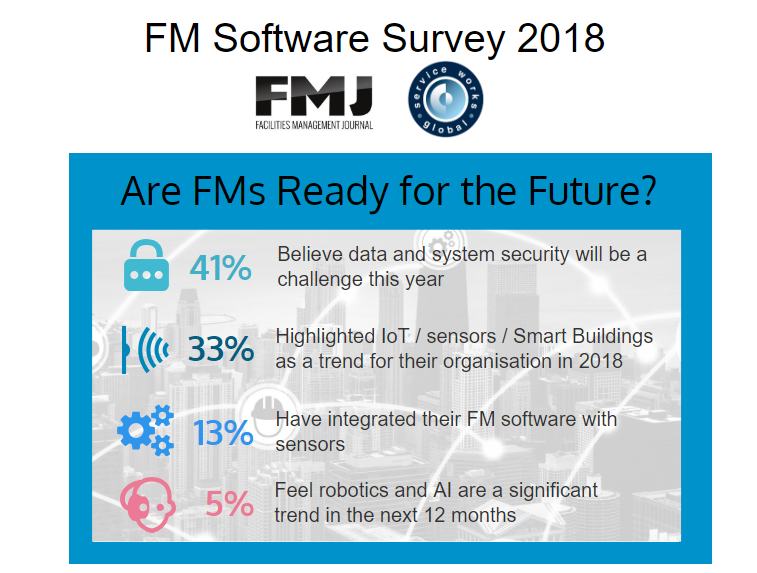Picture the future FM workforce: virtual receptionists, robot housekeepers, security conducted by drones and engineers seeing into walls with the aid of smart glasses. But how far into the future is this vision? While some early adopters are certainly reaping the benefits, according to the results of our FM Software Survey in partnership with FMJ, there are hurdles to overcome first across all sectors.
FM trends
As the infographic below shows, just 5% felt that robotics and AI will be of particular significance to their own organisation this year. 4% felt the use of drones (for example for surveillance or deliveries) would be a trend and 5% thought they may begin using blockchain. The internet of things (IoT) and smart buildings seem to have more immediate potential for application in FM, with 33% of respondents stating it will become relevant to them in 2018, although at the time of the survey, only 13% had integrated the sensors into their FM software system.
Budget
As discussed in the blog ‘Data Integration: Eliminating the Middle Man from FM Services’, FM budgets have increased on average, although service providers are most representative of this change. This group is also most likely to implement sensors this year, according to the results. Despite differing financial opportunities, budgetary pressure is felt evenly across public and private sectors and service providers, and the results show that budget may not be the only factor in the growth of smart FM.
Barriers to technology
The adoption and staff training for emerging technology can be a potential problem. It is becoming clear that more education is needed to prevent FMs being swept away by the tide of tech and skills shortages must be considered. Is the industry equipped to deal with the installation, usage, data analysis and protection of smart technology? Public and charity sector respondents perceived this as the biggest challenges (voted by 42% and 56% of each respectively) while only around a quarter of private sector and service providers felt this would present a problem.
Data and system security was the fourth most recognised challenge in FM (41% across all sectors). As sensor implementation becomes more accessible through lower costs and emerging examples of successful use by other companies, there are an equal number of examples of data theft, viruses and distributed denial-of-service (DDoS) attacks rendering systems unusable until payment is made. While security issues and hacking can be combatted through following best practice procedures, this can mean a company wide-culture change and training which can be inhibiting for those with larger organisational structures.
FM priorities
While the newest tech (AI, robots and blockchain etc) is not yet on the horizon for many, the survey revealed that respondents have a strong focus on improvement in other areas. Whole life asset costing to optimise and extend asset life and lower maintenance expenditure is a key trend for public sector and service providers; and mobile apps will remain key strategic priority for 55% of public sector respondents. The private sector’s focus will be on implementing self-service to improve the customer experience and reduce administration work, and respondents from charitable organisations felt space management would be of primary importance to them.
Budget is currently pricing some out of hardware, but the potential return on investment can outweigh the initial barrier to purchase. Sensors especially are expected to become embedded in FM, as CMMS now is, and similarly systems like AI and robotics will follow suit – although it remains to be seen to what degree. A lack of investment, or not least finding any time to investigate the potential, will save time and money in the short term but undoubtedly lead to future issues. Remaining static in this fast-moving environment is a risk, and FMs must dip their toes in the water to get ahead.
To receive Service Works’ weekly blog straight to your inbox, sign up to our email service: https://www.swg.com/blog-signup/
 Australia
Australia




